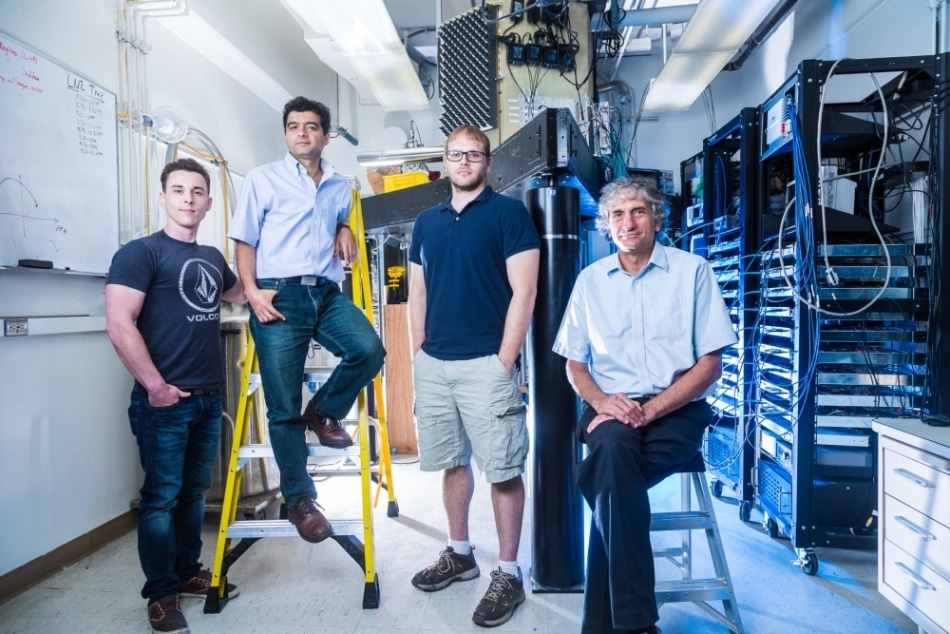Nov 1 2016
Researchers explore the delicate balance between coherence and control with a simple but complete platform for quantum processing
 Members of the John Martinis quantum computing group (l to r) : Charles Neill, Pedram Roushan, Anthony Megrant and John Martinis (Credit: Matt Perko)
Members of the John Martinis quantum computing group (l to r) : Charles Neill, Pedram Roushan, Anthony Megrant and John Martinis (Credit: Matt Perko)
If you’re building a quantum computer with the intention of making calculations not even imaginable with today’s conventional technology, you’re in for an arduous effort. Case in point: You’re delving into new problems and situations associated with the foundational work of novel and complicated systems as well as cutting-edge technology.
Such is life for the scientists of the Martinis Group at UC Santa Barbara and Google, Inc., as they explore the exciting but also still somewhat counter-intuitive world of quantum computing. In a paper published in the journal Nature Physics, they and colleagues at Tulane University in New Orleans demonstrate a relatively simple yet complete platform for quantum processing, integrating the control of three superconducting qubits.
“We’re probing the edge of our capability,” said the paper’s lead author, Pedram Roushan. There have been quite a few efforts to build and study individual parts of a quantum processor, he explained, but this particular project involves putting them all together in a basic building block that can be fully controlled and potentially scaled up into a functional quantum computer.
However, before a fully practicable quantum computer — with all its potential for vast, rapid and simultaneous calculations — can be made, various and sometimes unpredictable and spontaneous circumstances arise that have to be understood as the researchers pursue greater control and sophistication of their system.
“You’re dealing with particles — qubits in this case — that are interacting with one another, and they’re interacting with external fields,” Roushan said. “This all leads to very complicated physics.”
To help solve this particular many-body problem, he explained, their fully controllable quantum processing system had to be built from a single qubit up, in order to give the researchers opportunities to more clearly understand the states, behaviors and interactions that can occur.
By engineering the pulse sequences used to manipulate the spins of the photons in their system, the researchers created an artificial magnetic field affecting their closed loop of three qubits, causing the photons to interact strongly with not only each other, but also with the pseudo-magnetic field. Not a small feat.
“Naturally most systems where there is good control are photonic systems,” said co-author Charles Neill. Unlike electrons, charge-less photons generally tend not to interact with each other nor with external magnetic fields, he explained. “In this article we show that we can get them to interact with each other very strongly, and interact with a magnetic field very strongly, which are the two things you need to do to get them to do interesting physics with photons,” Neill said.
Another advantage of this synthetic condensed-matter system is the ability to drive it into its lowest-lying energy state — called the ground state — to probe its properties.
But with more control comes the potential for more decoherence. As the researchers strove for greater programmability and ability to influence and read the qubits, the more open their system was likely to be to error and loss of information.
“The more control we have over a quantum system, the more complex algorithms we would be able to run,” said co-author Anthony Megrant. “However, every time we add a control line, we’re also introducing a new source of decoherence.” At the level of a single qubit, a tiny margin of error may be tolerated, the researchers explained, but even with a relatively small increase in the number of qubits, the potential for error multiplies exponentially.
“There are these corrections that are intrinsically quantum mechanical, and then they start to matter at the level of precision that we’re getting at,” Neill said.
To combat the potential for error while increasing their level of control, the team had to reconsider both the architecture of their circuit and the material that was being used in it. Instead of their traditionally single-level, planar layout, the researchers redesigned the circuit to allow control lines to “cross over” others via a self-supporting metallic “bridge.” The dielectric — the insulating material between the conducting control wires — was itself found to be a major source of errors.
“All deposited dielectrics that we know of are very lossy,” Megrant said, and so a more precisely fabricated and less defective substrate was brought in to minimize the likelihood of decoherence.
Progress is incremental but solid, according to the researchers, who continue to explore the true potential of their quantum system. Add to that delicate dance speed, which is essential for the kind of performance they want to see in a fully operational quantum computer. Slow speeds reduce control errors but make the system more vulnerable to coherence limits and defects imposed by the materials. Fast speeds avoid the influence of defects in the material but reduce the amount of control the operators have over the system, they said.
With this platform, however, scaling up will be a reality of the not-too-distant future, they said.
“If we can control these systems very precisely — maybe at the level of 30 qubits or so — we can get to the level of doing computations that no conventional computer can do,” Roushan said.